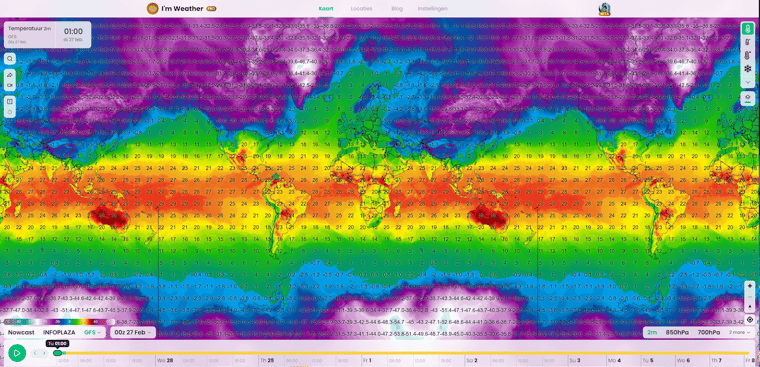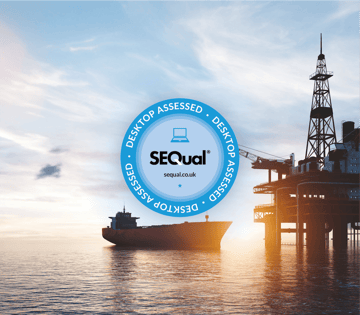For several years, the concept of AI (Artificial Intelligence) has been increasingly prevalent. AI is also being applied in more and more ways. This enables the resolution of problems that seemed unsolvable in the past. But what is AI exactly? How does it work? And what are the developments in AI in the (marine) weather industry? In this article, we will delve further into these questions.
Disclaimer: This article is not generated by AI itself, but written by Arjan Willemse and Christian Versloot.
What is AI?
AI, or Artificial Intelligence, refers to the simulation of human intelligence processes by machines, especially computer systems. These processes include learning, reasoning, and self-correction. A simple example of this is the following: an AI model can distinguish between a banana and an orange in a picture. This is done by feeding huge amounts of different pictures of bananas and oranges into the AI model. The model can train itself in distinguishing between a banana and a picture of an orange. If enough training material (different pictures of oranges and bananas) are fed into the model the model will be able to distinguish between pictures of bananas and oranges. When a completely new picture is presented to the model, the AI model is trained to predict whether this new picture is an orange or a banana. This example is about machine learning (which is a form of AI). There are many other forms of AI such as rule-based learning, symbolic AI, etc.
AI in weather forecasting:
In recent years, the usage of AI in weather forecasting has increased in both niche applications and global weather forecasting. The difference between the two lies in the scope of what is forecasted: niche applications attempt solving one task, such as nowcasting of lightning or improving an issued weather forecast based on observations. Global forecasting, a paradigm called Machine Learning Weather Prediction (MLWP), attempts to predict how the global atmosphere evolves over time, just like a classic weather model does.
One example of niche applications Infoplaza is researching is generating short-term cloud nowcasts based on recent satellite imagery. A bit more futuristic is attempting to predict radar images from satellite images using generative AI techniques, potentially helping us to predict storms on radar when they are in the process of forming. This may extend the lead time with which thunderstorms can be identified based on current weather conditions.
In MLWP, typically, around 40 years of observations data processed into a physics-based weather model (a so-called analysis) is used to predict how the atmosphere evolves. While attempting the same as a classic global weather model (an NWP model, which attempts making weather forecasts in a physically correct way), the technology behind it is radically different. Benefiting from technological developments used in recently emerged tools like ChatGPT, the meteorological sciences are attempting to predict the state of the atmosphere at 1, 3, 6, 12 or 24 hours ahead by passing the state at the current time through a large-scale machine learning model, then instructing it to predict the state at the expected time step. By doing this with 40 years of examples, a series of promising models has emerged which renowned weather institutes call potential rivals to classic NWP.
Strengths and weaknesses of AI forecasting:
MLWP is a new paradigm. Much research work is put into making increasingly well-performing models. With multiple models being released, large-scale verification has identified various strengths and weaknesses of these models. In this part, we will go over them step by step. Some strengths are that:
- Generating MLWP forecasts is much cheaper than NWP forecasts. Once an MLWP model is trained (which takes considerable time and resources), generating new forecasts – a process called inference – is extremely fast. This is a huge benefit in weather forecasting. Nowadays, large supercomputers need to run for hours and hours to produce a weather forecast. AI is able to do produce a weather forecast on your own computer in a matter of minutes.
- Some MLWP models perform better than NWP from the medium term onwards. Benchmarking studies, such as WeatherBench, show that some models perform better than ECMWF’s NWP model for some variables. Especially newer MLWP models show competitive performance on surface-level variables, too. One of the most differentiating aspects of MLWP models compared to NWP is the positioning of large-scale storm systems, such as tropical cyclones, from 3 to 5 days onwards.
- Uncertainty can be reduced further by wider scenario forecasts. Scenario forecasts, or ensemble forecasts, are used to estimate uncertainty of expected weather events. In NWP, the same model is run multiple times with disturbed inputs to see how the forecast evolves. Typically, this is done 10 to 50 times for a model run. Benefiting from the speed with which MLWP forecasts can be generated, a much broader set of ensemble forecasts can be generated, potentially further reducing uncertainty. This is an area of active research.
.png?width=1500&height=721&name=weather-forecasting-and-ai-MLWP%20(1).png) The output of a variety of MLWP models is currently updated daily and can be viewed via ecmwf.int.
The output of a variety of MLWP models is currently updated daily and can be viewed via ecmwf.int.
Weaknesses of MLWP models include that:
- They are not fully interpretable nor physically consistent by design. NWP models respect the laws of physics; MLWP models do not necessarily do so but learn from many years of data. What’s more, it is currently not possible to investigate what parts of the atmosphere have caused a different part to evolve. For example, when extreme systems form, it is currently unknown why they have done so.
- They are limited in variables and time resolution. NWP models produce a large variety of variables – such as temperature, wind speed and precipitation – at various levels in the atmosphere. Due to computational restraints during training, MLWP models are producing a significantly smaller set of variables. What’s more, compared to NWP models which typically produce forecasts in time steps of 1, 3 or 6 hours, the current generation of MLWP models typically produces them in 6-hour steps only.
- They are limited to the resolution of training data. High-resolution models, such as the ones generated by Infoplaza, have a resolution of a few hundred meters to a few kilometers. The current generation of MLWP models has a resolution of 0.25 degrees, which is between 25 and 30 kilometers. This is by consequence of the training data, which often has the same resolution. While changing this is difficult, research initiatives are underway that attempt moving away from analyses and using observations directly.
In summary, while AI brings significant strengths to weather forecasting, it has also its limitations related to data dependencies and interpretability. A hybrid approach, combing AI with traditional meteorological methods, is often seen as a promising strategy to combine the best of both worlds.
Conclusion
This article shows that AI has developed fast during recent years. Nowadays it is possible to forecast the weather (still with its limitations) purely based on AI models. That is already a huge achievement, accomplished in a short period of time. The expectation is that AI will keep developing during the coming years. Therefore, we will likely see an increase in AI based weather forecasts in the future.
Want to know more?
At Infoplaza, a dedicated weather room with experienced marine meteorologists is ready to support your offshore operations, 24/7. Along with our Marine Weather Dashboard, you always have access to the most expert view on weather situations, so you can excel at decision making.




